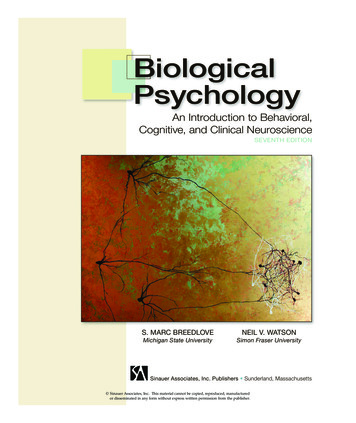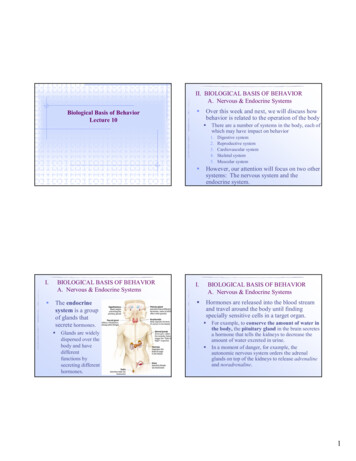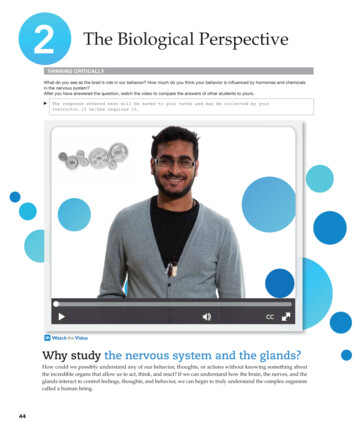
Transcription
Chapter 2Neuroscience andBehavior
NeuralCommunication Biological Psychology branch of psychology concerned with the linksbetween biology and behavior some biological psychologists call themselvesbehavioral neuroscientists, neuropsychologists,behavior geneticists, physiologicalpsychologist, or biopsychologists Neuron a nerve cell the basic building block of the nervous system
NeuralCommunication Dendrite the bushy, branching extensions of a neuron thatreceive messages and conduct impulses toward thecell body Axon the extension of a neuron, ending in branchingterminal fibers, through which messages are sent toother neurons or to muscles or glands Myelin [MY-uh-lin] Sheath a layer of fatty cells segmentally encasing the fibers ofmany neurons enables vastly greater transmission speed of neutralimpulses
NeuralCommunication
NeuralCommunication Action Potential a neural impulse; a brief electrical charge thattravels down an axon generated by the movement of positivelycharges atoms in and out of channels in theaxon’s membrane Threshold the level of stimulation required to trigger aneural impulse
NeuralCommunication Synapse [SIN-aps] junction between the axon tip of the sending neuronand the dendrite or cell body of the receiving neuron tiny gap at this junction is called the synaptic gap orcleft Neurotransmitters chemical messengers that traverse the synaptic gapsbetween neurons when released by the sending neuron, neurotransmitters travel across the synapse and bind toreceptor sites on the receiving neuron, therebyinfluencing whether it will generate a neural impulse
NeuralCommunication
NeuralCommunicationSerotonin PathwaysDopamine pathways
NeuralCommunication
NeuralCommunication Acetylcholine [ah-seat-el-KO-leen] a neurotransmitter that, in addition to its rolein learning and memory, triggers musclecontraction Endorphins [en-DOR-fins] “morphine within” natural, opiatelike neurotransmitters linked to pain control and to pleasure
r site onreceiving neuronReceiving cellmembraneAgonist tter
The Nervous System Nervous System the body’s speedy, electrochemicalcommunication system consists of all the nerve cells of the peripheraland central nervous systems Central Nervous System (CNS) the brain and spinal cord Peripheral Nervous System (PNS) the sensory and motor neurons that connectthe central nervous system (CNS) to the restof the body
The Nervous SystemNervoussystemCentral(brain andspinal cord)PeripheralAutonomic (controlsself-regulated action ofinternal organs and glands)Skeletal (controlsvoluntary movements ofskeletal ng)
The Nervous System Nerves neural “cables” containing many axons part of the peripheral nervous system connect the central nervous system withmuscles, glands, and sense organs Sensory Neurons neurons that carry incoming information fromthe sense receptors to the central nervoussystem
The Nervous System Interneurons CNS neurons that internally communicate andintervene between the sensory inputs andmotor outputs Motor Neurons carry outgoing information from the CNS tomuscles and glands Somatic Nervous System the division of the peripheral nervous systemthat controls the body’s skeletal muscles
The Nervous System Autonomic Nervous System the part of the peripheral nervous system thatcontrols the glands and the muscles of theinternal organs (such as the heart) Sympathetic Nervous System division of the autonomic nervous system thatarouses the body, mobilizing its energy instressful situations Parasympathetic Nervous System division of the autonomic nervous system thatcalms the body, conserving its energy
The Nervous System
The Nervous System
The Nervous System Reflex a simple, automatic, inborn response to a sensoryBrainstimulusSensory neuron(incoming information)MuscleSkinreceptorsMotor neuron(outgoinginformation)InterneuronSpinal cord
The Brain Brainstem the oldest part and central core of the brain,beginning where the spinal cord swells as itenters the skull responsible for automatic survival functions Medulla [muh-DUL-uh] base of the brainstem controls heartbeat and breathing
The Brain Reticular Formation a nerve network in the brainstem that playsan important role in controlling arousal Thalamus [THAL-uh-muss] the brain’s sensory switchboard, located ontop of the brainstem it directs messages to the sensory receivingareas in the cortex and transmits replies tothe cerebellum and medulla
The Brain
The Brain Cerebellum [sehruh-BELL-um] the “little brain”attached to therear of thebrainstem it helps coordinatevoluntarymovement andbalance
The Brain Lesion tissuedestruction a brain lesion isa naturally orexperimentallycauseddestruction ofbrain tissue
Electroencephalogram(EEG) an amplifiedrecording of thewaves of electricalactivity that sweepacross the brain’ssurface these waves aremeasured byelectrodes placedon the scalp
The Brain Computed Tomography (CT) Scan a series of x-ray photographs taken from different anglesand combined by computer into a composite representationof a slice through the body. Also called CAT scan Positron Emission Tomography (PET) Scan a visual display of brain activity that detects where aradioactive form of glucose goes while the brain performs agiven task Magnetic Resonance Imaging (MRI) a technique that uses magnetic fields and radio waves toproduce computer-generated images that distinguish amongdifferent types of soft tissue; allows us to see structureswithin the brain
PET Scan
MRI Scan
The Brain Limbic System a doughnut-shaped system of neural structures at theborder of the brainstem and cerebral hemispheres associated with emotions such as fear and aggressionand drives such as those for food and sex includes the hippocampus, amygdala, andhypothalamus. Amygdala [ah-MIG-dah-la] two almond-shaped neural clusters that arecomponents of the limbic system and are linked toemotion
The Brain Hypothalamus neural structure lyingbelow (hypo) thethalamus; directs severalmaintenance activities eating drinking body temperature helps govern theendocrine system via thepituitary gland is linked to emotion
The Limbic System
The Limbic System Electrodeimplanted inrewardcenter
The Cerebral Cortex Cerebral Cortex the intricate fabric of interconnectedneural cells that covers the cerebralhemispheres the body’s ultimate control andinformation processing center Glial Cells cells in the nervous system that support,nourish, and protect neurons
The Cerebral Cortex Frontal Lobes involved in speaking and muscle movements and inmaking plans and judgments Parietal Lobes include the sensory cortex Occipital Lobes include the visual areas, which receive visualinformation from the opposite visual field Temporal Lobes include the auditory areas
The Cerebral Cortex
The Cerebral Cortex Motor Cortex area at the rear of the frontal lobes thatcontrols voluntary movements Sensory Cortex area at the front of the parietal lobes thatregisters and processes body sensations
The Cerebral Cortex
The Cerebral Cortex Functional MRIscan shows thevisual cortexactivated as thesubject looks atfaces
Visual and AuditoryCortex
Association Areas More intelligent animals have increased“uncommitted” or association areas of the cortex
The Cerebral Cortex Aphasia impairment of language, usually caused by lefthemisphere damage either to Broca’s area(impairing speaking) or to Wernicke’s area(impairing understanding) Broca’s Area an area of the left frontal lobe that directs themuscle movements involved in speech Wernicke’s Area an area of the left temporal lobe involved inlanguage comprehension and expression
Specialization andIntegration
Specialization andIntegration Brain activity when hearing, seeing, and speakingwords
Brain Structures andtheir Functions
Brain Reorganization Plasticity the brain’s capacity for modification, as evident inbrain reorganization following damage (especiallyin children) and in experiments on the effects ofexperience on brain development
Our Divided BrainCorpus callosum CorpusCallosum large band ofneural fibers connects thetwo brainhemispheres carriesmessagesbetween thehemispheres
Our Divided Brain Theinformationhighway fromthe eye to thebrain
Split Brain a condition in whichthe two hemispheresof the brain areisolated by cuttingthe connecting fibers(mainly those of thecorpus callosum)between them
Split Brain“What worddid you see?”or“Look at the dot.”Two words separatedby a dot aremomentarily projected.“Point withyour lefthand to theword yousaw.”
The EndocrineSystem Endocrine System the body’s “slow”chemicalcommunicationsystem a set of glandsthat secretehormones into thebloodstream
Neural and HormonalSystems Hormones chemical messengers, mostly those manufactured by theendocrine glands, that are produced in one tissue andaffect another Adrenal [ah-DREEN-el] Glands a pair of endocrine glands just above the kidneys secrete the hormones epinephrine (adrenaline) andnorepinephrine (noradrenaline), which help to arouse thebody in times of stress Pituitary Gland under the influence of the hypothalamus, the pituitaryregulates growth and controls other endocrine glands
Biological Psychology branch of psychology concerned with the links between biology and behavior some biological psychologists call themselves behavioral neuroscientists, neuropsychologists, behavior geneticists, physiological psychologist, or biopsychologists Neuron a










